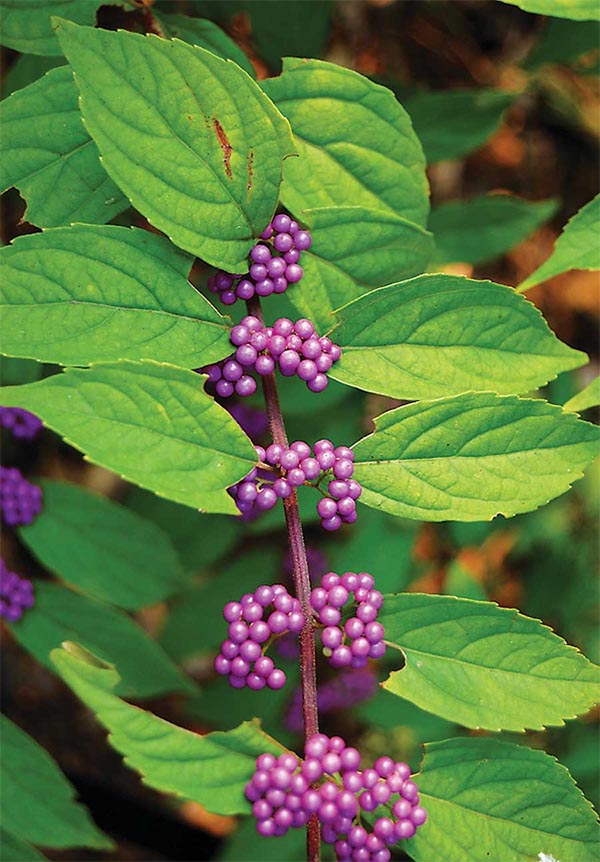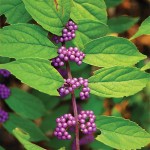Natural Insect Repellent: Beautyberry Banishes Bad Biting Bugs

Not just pretty: chemical compounds in Beautyberry leaves are natural insect repellents.
PHOTO: DEREK RAMSEY
Warm weather brings out the big three of biting bugs: mosquitoes that transmit West Nile virus, deer ticks that carry Lyme disease and, in warm climates, fire ants that can quickly take over your yard. Instead of using toxic DEET to protect yourself, wouldn’t it be great to use leaves gathered from a native shrub?
This is exactly what you can do with beautyberry (Callicarpa americana ), a deciduous
shrub of the southeastern woods best known for its bracelet-like clusters of showy purple berries that ripen in fall. Compounds found in beautyberry leaves have shown amazing natural insect repellent properties, proving the worth of the centuries-old practice of placing leaves under mule harnesses to deter biting insects.
In 2006, researchers at the U.S. Department of Agriculture’s Natural Products Utilization Research Unit in Oxford, MS, found that extracts from beautyberry leaves could match DEET for repelling mosquitoes. The next year, experiments showed that the active ingredients from the leaves (callicarpenal and intermedeol) provided 100-percent repellency of black-legged ticks for three hours. In 2008, the four-person research team, headed by chemist Charles Cantrell in Mississippi and entomologist Jerome Klun in Maryland, published research that added fire ants to the list of pests repelled by essential oil distilled from beautyberry leaves.
Cantrell says toxicity testing is needed to evaluate the safety of applying potent beautyberry compounds to human skin. “Plants containing these compounds have long been used as folk remedies with no ill effects that we know of, so I would not anticipate any harmful effects when plants are used in the traditional way,” he says. Fresh green leaves, crushed and rubbed on people or pets, often repel insects for a couple of hours.
American beautyberry is easily grown in moist, partial shade in Zones 7 to 9, and in protected sites near buildings in Zone 6. Among ornamental species, Cantrell notes that leaves of Japanese beautyberry (C. japonica , hardy to Zone 5) contain both compounds.
Container-grown plants of American beautyberry are widely available from native plant nurseries. Visit the MOTHER EARTH NEWS Seed and Plant Finder to find a source near you.
Related Content
Mosquito Problems? Bring on the Bats
One small brown bat can eat several thousand insects each night. Install a bat house and invite them…
An Effective and Non-Toxic Solution for Getting Rid of Yellow Jackets’ Nests
Yellow jackets can pose a threat to honeybees. If yellow jackets have built a nest in your yard, her…
Spiders in Your Bathtub?
Suddenly it seems like spiders are everywhere, which makes many people uneasy. Fear not! Autumn’s aw…
Non-Toxic Herbal Insect Repellent Spray
It’s that time of year when the flying, buzzing, blood-sucking insects are at their peak annoyance, …








 Photographer Finds Locations Of 1960s Postcards To See How They Look Today, And The Difference Is Unbelievable
Photographer Finds Locations Of 1960s Postcards To See How They Look Today, And The Difference Is Unbelievable  Hij zet 3 IKEA kastjes tegen elkaar aan en maakt dit voor zijn vrouw…Wat een gaaf resultaat!!
Hij zet 3 IKEA kastjes tegen elkaar aan en maakt dit voor zijn vrouw…Wat een gaaf resultaat!!  Scientists Discover 512-Year-Old Shark, Which Would Be The Oldest Living Vertebrate On The Planet
Scientists Discover 512-Year-Old Shark, Which Would Be The Oldest Living Vertebrate On The Planet  Hus til salg er kun 22 kvadratmeter – men vent til du ser det indvendigt
Hus til salg er kun 22 kvadratmeter – men vent til du ser det indvendigt  Superknepet – så blir snuskiga ugnsformen som ny igen!
Superknepet – så blir snuskiga ugnsformen som ny igen!  Meteorite That Recently Fell in Somalia Turns Out to Contain Two Minerals Never Before Seen on Earth
Meteorite That Recently Fell in Somalia Turns Out to Contain Two Minerals Never Before Seen on Earth  Nearly Frozen Waves Captured On Camera By Nantucket Photographer
Nearly Frozen Waves Captured On Camera By Nantucket Photographer  It’s Official: Astronomers Have Discovered another Earth
It’s Official: Astronomers Have Discovered another Earth 